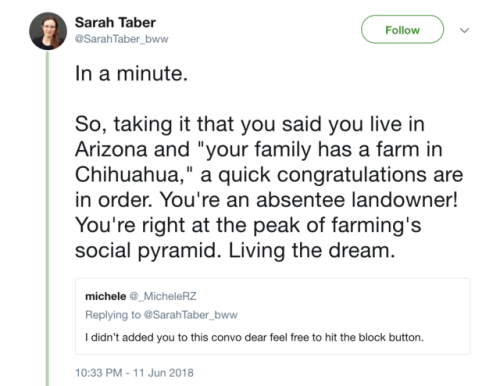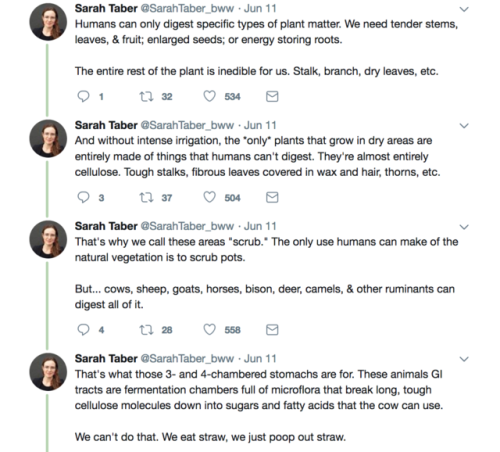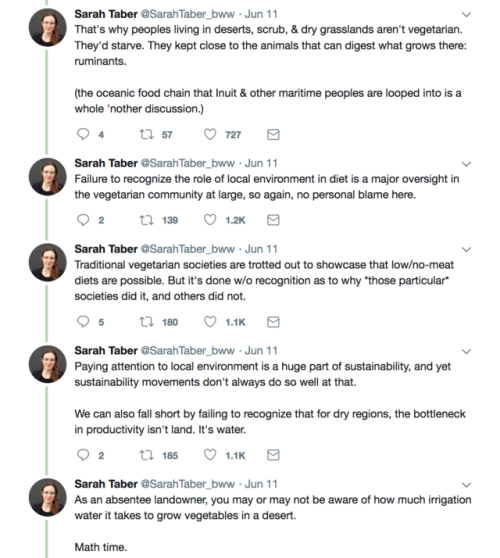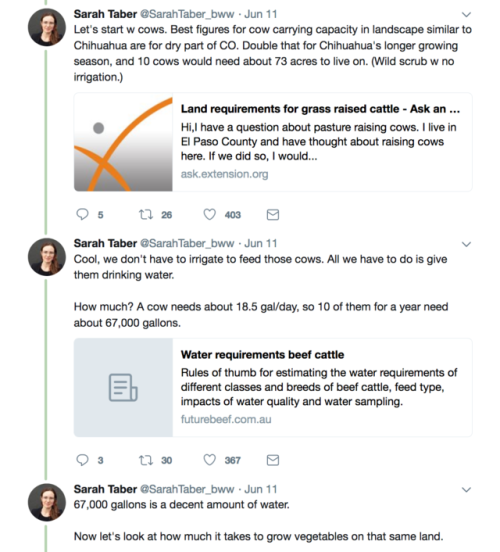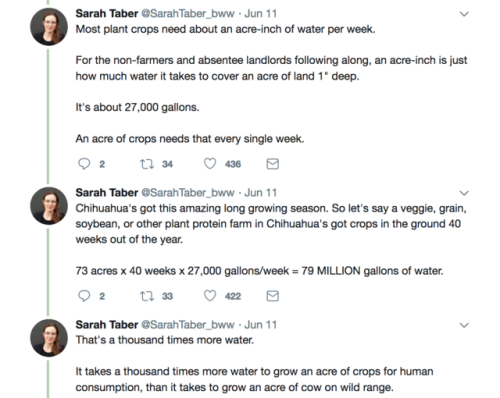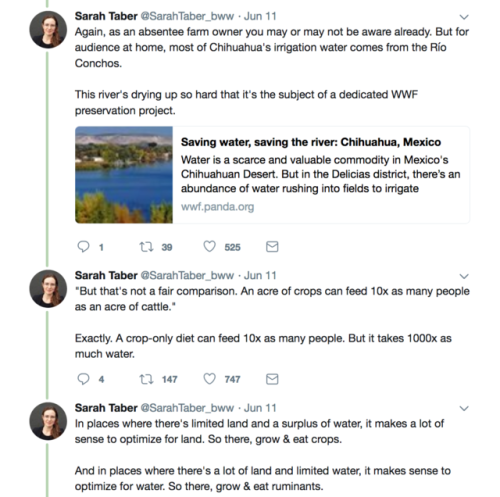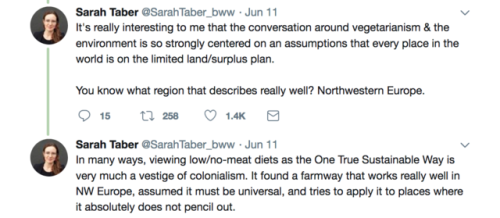systlin:kawuli:This person is my new best friendFarming systems need to fit into their natural and s
systlin:kawuli:This person is my new best friendFarming systems need to fit into their natural and social environment. Sometimes we describe this as a socio-ecological niche.Caption; In a minute.So, taking it that you said you live inArizona and “your family has a farm in Chihuahua,” A quickcongratulations are in order. You’re an absentee landowner! You’reright at the peak of farming’s social pyramid. Living the dream.So you probably don’t participate inthe day-to-day management, you just collect checks. Pretty commonsituation for absentee landlords. From that distance, it’sunderstandable that you have a poor grasp on water, land, and howthey play out in various types of agriculture.But let’s take a step back.Lots of cultures have used low or nomeat diets. The Ganges valley, ancient Egypt, China, much of earlyEurope, ect.Notice anything in common there?They’re all very, very wet. Plants thatare edible for humans grow readily.They also had intense hierarchies whereelites could just tell the lower classes they weren’t allowed to eatmeat-whether via religious teachings, custom, or just straight-upeconomic exploitation to where animal protein was unattainable. Butthat’s a whole different discussion.On the other hand, lots of cultureshave used mostly or all animal diets.E.G. The Bedouin, Mongols, Maasai,Inuit, ect.What do these have in common? They’rein places that are either very dry or very cold. Either the plantsthat grow are very sparse & tough, or none at all.Humans can only digest specific typesof plant matter. We need tender stems, leaves & fruit; enlargedseeds, or energy storing roots.The entire rest of the plant isinedible for us. Stalk, branch, dry leaves, ect.And without intense irrigation, theonly plants that grow in dry areas are entirely made of thingsthat humans can’t digest. They’re almost entirely cellulose. Toughstalks, fibrous leaves covered in wax and hair, thorns, ect.That’s why we call these areas ‘scrub’.The only use humans can make of the natural vegetation is to scrubpots.But…cows, sheep, goats, horses,bison, deer, camels & other ruminants can digest all of it.That’s what those 3 and 4 chamberedstomachs are for. These animals GI tracts are fermentation chambersfull of microflora that break long, tough cellulose molecules downinto sugars and fatty acids that the cow can use.We can’t do that. We eat straw, we justpoop out straw.That’s why people living in deserts,scrub & dry grasslands aren’t vegetarian. They’d starve. Theykept close to the animals that can digest what grows there;ruminants.(The oceanic food chain that Inuit &other maritime peoples are looped into is a whole ‘notherdiscussion.)Failure to recognize the role of localenvironment in diet is a major oversight in the vegetarian communityat large, so again, no personal blame here.Traditional vegetarian societies aretrotted out to showcase that low/no meat diets are possible. But it’sdone w/o recognition as to why ‘those particular’ societies did it,and others did not.Paying attention to local environmentis a huge part of sustainability, and yet sustainability movementsdon’t always do so well at that.We can also fall short by failing torecognize that for dry regions, the bottleneck in productivity isn’tland, it’s water.As an absentee landowner, you may ormay not be aware of how much irrigation water it takes to growvegetables in a desert. Math time.Let’s start w. cows. Best figures forcow carrying capacity in landscape similar to Chihuahua are for drypart of CO. Double that for Chihuahua’s longer growing season, and 10cows would need about 73 acres to live on (wild scrub w noirrigation.)Cool, so we don’t have to irrigate tofeed those cows. All we have to do is give them drinking water. Howmuch? A cow needs about 18.5 gal/day, so 10 of them for a year wouldneed about 67,000 gallons.67,000 gallons is a decent amount ofwater.Now let’s look at how much it takes togrow vegetables on that same land.Most plant crops need about anacre-inch of water per week.For the non-farmers and absenteelandlords following along, an acre-inch is just how much water ittakes to cover an acre of land 1” deep.It’s about 27,000 gallons.An acre of crops needs that everysingle week.Chihuahua’s got this amazing longgrowing season. So let’s say a veggie, grain, soybean or other plantprotein farm in Chihuahua’s got crops in the ground 40 weeks out ofthe year.73 acres x 40 weeks x 27,000gallons/week = 79 MILLION gallons of water.That’s a thousand times more water.It takes a thousand times more water togrow an acre of crops for human consumption, than it takes to grow anacre of cow on wild range.Again, as an absentee farm owner youmay or may not be aware already. But for audience at home, most ofChihuahua’s irrigation water comes from the Rio Conchos.The river’s drying up so hard that it’sthe subject of a dedicated WWF preservation project.“But that’s not a fair comparison. Anacre of crops can feed 10x as many people as an acre of cattle.”Exactly. A crop-only diet can feed 10xas many people. But it takes 1000x as much water.In places where there’s limited landand a surplus of water, it makes a lot of sense to optimize for land,so there, grow & eat crops.And in places where there’s a lot ofland and limited water, it makes sense to optimize for water, Sothere, grow & eat ruminants.It’s really interesting to me that theconversation around vegetarianism & the environment is sostrongly centered on assumptions that every place in the world is onthe limited land/surplus plan.You know what region that describesreally well? Northwestern Europe.In many ways, viewing low/no meat dietsas the One True Sustainable Way is very much a vestige ofcolonialism. It found a farmway that works really well in NW Europe,assumed it must be universal, and tries to apply it to places whereit absolutely does not pencil out. -- source link
#long post#nature#food#sustainability
